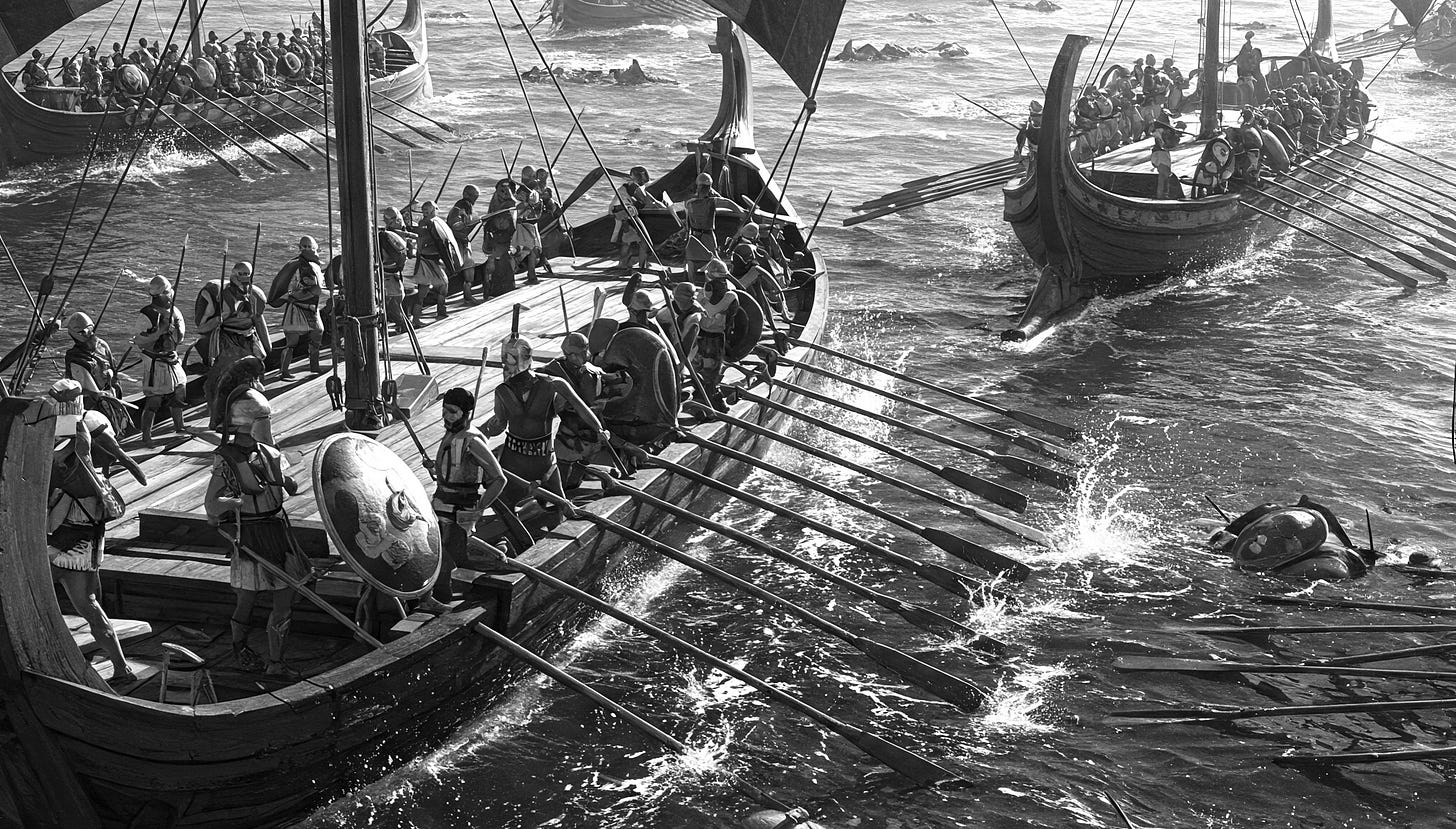From Triremes to Drones: Why Innovation Alone Won’t Win a War
A guest post by Stavros Messinis giving an important historical context to the debate about defence innovation and the role of doctrine
Throughout history, military doctrine has always lagged behind technology. Innovation is mostly a solo sport that’s driven by individuals, breakthroughs, and accidents, but doctrine demands consensus.
As the threat of Persian invasion loomed over ancient Athens, a fortuitous discovery of silver in the hills of Laurion in southern Attica gave Athens a choice: enrich the elite or invest in security. It took the strategic vision (and political cunning) of Themistocles to persuade the elites of the Polis to build a fleet of triremes instead of divvying up the wealth. That decision, marshalling resources to defeat a seemingly unbeatable foe, spurred on a doctrinal shift: from the land based hoplite to toward naval power. It laid the foundation for the Athenian victory at Salamis and, arguably, the birth and survival of Western democracy itself. The trireme was fast, agile and above all, new. It sailed with a heavy bronze ram on its bow, a technological advancement. The adversary fought with waterlogged and barnacle infested ships. They were heavy and slow. They didn’t stand a chance.
Contrast that with another moment of tragic rigidity a millennium later. In the waning days of the Byzantine Empire, as the Ottoman threat closed in, a Hungarian engineer named Urban offered his revolutionary siege cannon to Emperor Constantine XI. As new technologies go, it probably wasn’t cheap, and let’s face it, security is never cheap. The emperor, constrained by treasury, tradition, or mistrust, declined the offer. His walls had stood for a thousand years. Urban then took his services to Sultan Mehmed II. Months later, those very cannons (some stretching over 25 feet in length) were hammering the thousand year old Theodosian Walls of Constantinople. For centuries, those walls had symbolized the impenetrability of the Christian East. But no fortification is eternal when doctrine refuses to evolve with technology. In failing to grasp that the age of gunpowder required a new way of defending, the Byzantines fell, not for lack of courage, but for lack of imagination.
The Ottomans themselves, once pioneers of gunpowder warfare, eventually faced their turn to stumble, unable to sustain the demands of modern total war, outpaced by industrialized armies and the very kind of innovation they had once wielded to bring down empires.
There are countless examples of this process, Shaka’s short spear and bulls horn encirclement tactic over ceremonial spear throwing made him an emperor. Swiss, and later Spanish, pike formations neutralised cavalry dominance, reshaping medieval battlefields. Doctrine, not metallurgy, let infantry hold ground and ushered in the professional soldier.
History doesn’t reward the side with the best tools, it rewards the side that knows how to use them differently. From cavalry charges into machine guns, to fortress walls against gunpowder, to centralised C2 in a world of distributed drone warfare, clinging to outdated doctrine has repeatedly led to avoidable defeat.
Great militaries don’t only adopt new technology, they must completely absorb its implications. The refusal to adapt isn’t conservatism; it’s malpractice. Victory belongs to those who rewrite the playbook when the rules change.
In WWII, the French command was fixated on a WWI-style static defence, investing heavily in the Maginot Line, assuming Germany would repeat a frontal assault. The result? German speed and diesel power bypassed the line through the Ardennes. This Blitzkrieg innovation led to France’s rapid collapse in just 46 days in 1940. It ultimately took the full-scale industrial mobilisation of Great Britain, the United States and the Soviet Union’s brutal campaign on the Eastern Front to halt and reverse the momentum of that initial doctrinal failure. A multitude of innovations emerged, the liberty ship, the dam busting bombs, radar, Turing’s work with the codebreakers at Bletchley Park and more.
And yet, for all the power of innovation, it’s never enough. Themistocles wasn’t a shipwright. Urban didn’t storm the walls. Shaka didn’t forge every spear. In each case, the decisive edge came not from solo genius, but from the ability to turn innovation into doctrine, and doctrine into collective action.
Today’s battlefield is no different. A brilliant engineer can design the perfect drone, the ideal sensor, the next-generation networked weapon, but if there’s no shared concept of how it’s used, if there’s no buy-in from commanders, trainers, logisticians, and warfighters, it’s just another prototype gathering dust.
We cannot beat the enemy solo. Not as inventors. Not as units. Not as nations. We need to build consensus, not just around resources, but around doctrine. We need shared playbooks, not just better hardware. Winning doesn’t come from building the best tool, it comes from adapting the way we fight around what that tool makes possible.
Innovation is potential. Doctrine is power. Integration is victory.
Victory demands more than invention, it demands integration. And that takes all of us.
Stavros Messinis is a creative technologist who founded several pioneering ventures, including The Cube Athens, one of the country’s first startup incubators and co-working spaces, and Smart Flying Machines, a builder of fixed wing UAVs serving security and climate resilience objectives (Acquired by Delian). He currently serves as an innovation consultant at INTERWEAVE.




Great post!